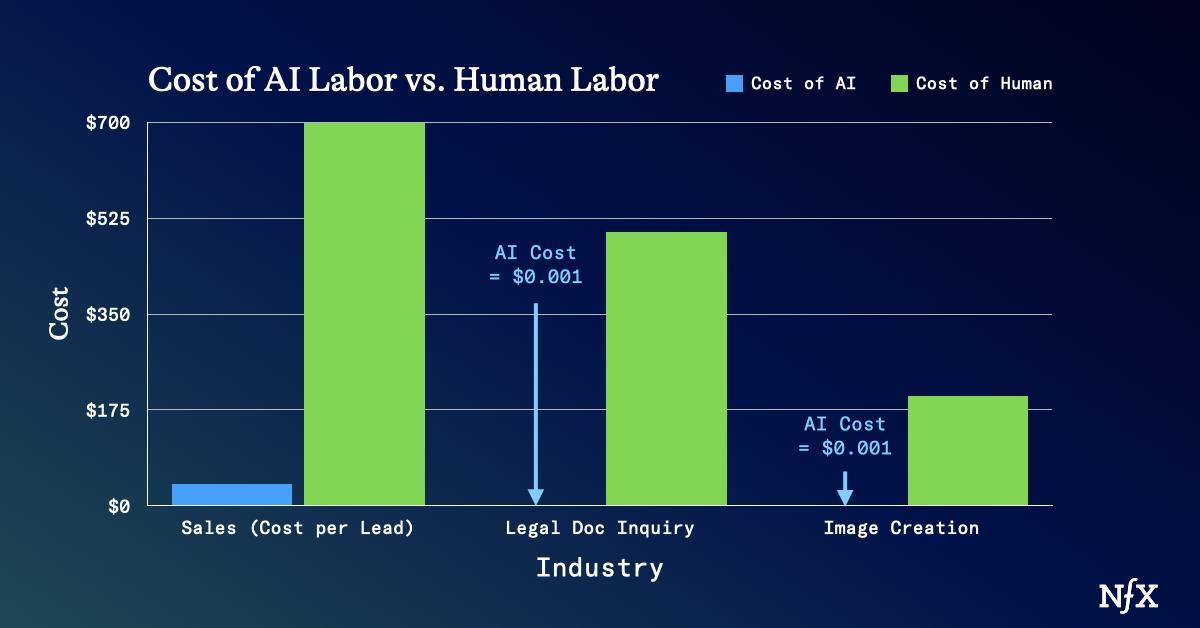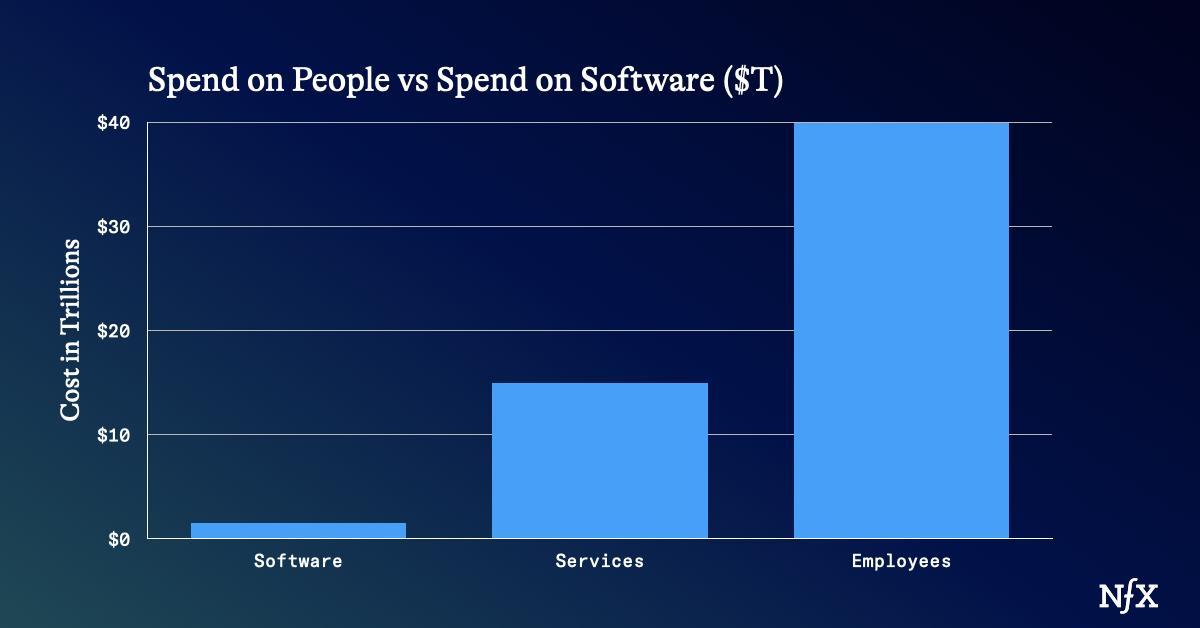

With traditional B2B SaaS, we augmented human work and services with software. Now, the software itself is doing the whole job.
AI is forcing a reversal of the SaaS acronym. From Software-as-a-Service to Service-as-a-Software.
The big picture: the rise of AI workers is creating a fusion of the software and labor market. This is going to create massive opportunities for Founders.
Labor and Software Are Becoming One Market
SaaS companies have historically brought analog processes into the digital world. They were aimed at making certain aspects of existing job descriptions easier to manage.
But SaaS could never run itself. It always required a company to maintain a workforce to operate that software.
For example, you could purchase a SaaS sales tool but you still had to hire, and train a salesperson to do the work.
Across the whole economy, this means the labor market, and the software markets have been separate – and within a company, the hiring budget has always been orders of magnitude larger than the software budget.
If you run a very rough calculation, US businesses spend upwards of $5 trillion on knowledge workforces. By comparison, companies spend about $230 billion on B2B SaaS.
Now, software can both organize and execute tasks. Labor and software are fusing into one massive market.


This opportunity, however, is not just about market expansion. It’s also about margin expansion.
In this labor transition, we expect the historical margin gap between service businesses (below 30%) and SaaS businesses (above 80%) to shrink as AI services replace human-centric services enabled by SaaS tools. Service margins will become software margins.


Market and margin expansions combined are creating opportunities for new tech companies to emerge in areas not yet touched by traditional software.
Note that these estimates only tackle knowledge work. We expect this concept to expand into more manual tasks as well. This will happen as new bridges between Generative AI and the physical world are created in the future. Construction and manufacturing, large sections of the labor market, are likely the first to witness these changes. (We have briefly covered the emergence of this in construction here).
We do expect some roles to disappear as this fusion accelerates. But AI is likely to create a form of Jevons paradox in the long run – where increased efficiency leads to a short term reduction in a resource, but a long-term surge in demand that creates more resource use.
Applied here, that means we expect to see more demand for these types of services in the future, providing more job opportunities. To aid with that, AI also provides the opportunity for rapid workforce re-skilling, allowing people to shift careers and align themselves with those opportunities.
Labor is going to be “baked in” to any software an enterprise buys. Meet your new AI colleagues.
Two Approaches to “AI Workforce” Companies
So far, we’re seeing two dominant approaches to building companies in this space.


1. Sell “AI Colleagues” (Internal)
The first approach is to sell into an existing job description.
A good example of this would be Devin, Cognition Lab’s “AI software engineer.”
First, Devin works across the whole software engineer’s workflow. It encounters issues and finds solutions, and tells you what it’s doing along the way. It works like human labor – down to the communication styles.
Other examples in this vein would be 11x or Artisan, companies creating “digital SDRs.” In this case, Alice and Ava are able to book 2-3 prospective client meetings per week, work 24/7, and work across the whole sales technology stack. In the legal space, our portfolio company EvenUp has replaced the demand letter writing process with AI automation.
Finally, a company on the leading edge of this developing space would be NVIDIA and Hippocratic.ai’s AI-powered healthcare agents. These AI “nurses” conduct patient interviews, perform health-risk assessments, and perform post-operative follow ups.
In this case, AI falls short of providing the whole spectrum of care provided by a human nurse, but may lessen the burden on human nurses (currently in the midst of a prolonged labor shortage).
Here we see a developing spectrum of “AI colleagues.” They are not only adept at basic job functions, but also posses a range of “soft skills” that make them more like colleagues than software.
2. Sell “AI Vendors/ Services” (External)
The second approach is to automate an entire workflow that would typically encompass many different jobs. This concept will basically replace the work provided by an entire service business. E.g. a full stack AI law firm, an AI broker, etc.
This comes in several flavors.
The first flavor, and what we see a lot of right now, is a re-imagination of the existing BPO.
This is likely to happen in fields like: customer service, Sales, marketing, finance & accounting, supply chain management (logistics & procurement), legal services, data collection/entry/analysis, human resources, translation & localization, software development, quality assurance, cybersecurity, or construction takeoff and estimation.
We’re already seeing this happen. Our portfolio company Smith.ai has developed AI-powered customer service agents specifically for SMBs. Their platform can respond to customer calls and messages 24/7, with the accuracy usually required by hiring large teams of human specialists.
The second flavor is the creation of a new type of “firm” that couldn’t exist under one roof without AI.
The key to this playbook is to seek fragmented processes that require multiple stakeholders. Architecture or renovation services are other great examples of this because of equal ratios of analog and digital tasks.
This category of business is capable of encompassing both the “services” market and the “labor/employee” market. In both cases, you deliver human-quality labor with software margins.
An added benefit is that this trend also creates an opportunity to disrupt SaaS incumbents. First, certain SaaS tools will become superfluous as AI service providers build the tools they need internally. Secondly, there may be business model conflicts. The pay-per-seat models increases revenues provided headcount keeps increasing – and initially, AI workforces will decrease that headcount.
Overall, SaaS spending may go down, disrupt SaaS incumbents, and create more space for startups.
Which is why this opportunity is truly big. Even bigger than enterprise software.


Where Will AI Workers First Dominate?
The biggest opportunities will exist where the unit economics of hiring AI are 100x better than the unit economics of hiring or subcontracting a person to do the job. Under those conditions, for AI workers will thrive.
That is usually achieved via a combination of AI’s cost-cutting capabilities (automating repetitive work etc), AND AI’s added value (driving greater revenues via enhanced personalization).
Here’s how we look for spaces with those characteristics:
First, we ask: where does AI excel where human labor may be weak?
There are several key factors here:
- Large amount of process is automatable. This includes simple, repetitive, high volume tasks. This likely does not include complex, multi-step, bespoke tasks, initially.
- Human labor is particularly expensive.
- Hiring is difficult and there are poor labor market dynamics (including worker shortages and attrition)
- Long “time to ROI” for human workers (e.g. significant onboarding/ training required)
- High level of tool fragmentation, which provides an opportunity to consolidate tools into one top layer.
- High fault tolerance: i.e. the stakes are not life or death.
- Fields with large amounts of training data – preferably proprietary
An example of areas where AI excels here would be legal document inquiry, account payable positions, social media content moderation, data entry, or basic customer service.
Second, we ask: Where does AI add additional value that may go beyond that of a human worker?
- Personalization will drive significant customer value
- Speed is a key factor in service quality, and 24/7 service matters
- Heterogeneity is a hindrance to high quality service
To illustrate both, let’s take education for example. There are cost advantages to AI tutors over human teachers (about 80x cheaper, if you compare Khan Academy’s AI tutor to the salary of a public school teacher, for example).
While it is unlikely that AI will replace public school teachers in our lifetime, we will likely see AI play an increasingly large role in education in other ways. The more transformational application of this technology is in the additional market for customized education that these AI tutors create.
AI tutors are available 24/7. In theory, they should be able to instantly tailor teaching styles to student needs. It’s instant personalized learning that can happen outside of a traditional classroom.
This is an area where we see AI-driven industry expansion, rather than AI-driven automation and replacement.


Who Will Be the First to Adopt AI Workers?
We expect the first adopters to be operations-heavy companies or SMBs. These AI companies should open additional pathways to scale for these businesses, which have traditionally scaled linearly with labor, and are constrained by their ability to add new employees.
Now they’ll be able to increase their workforce at the click of a button. And equally decrease it, accessing infinite scale and flexibility.
For these businesses AI provides infinite leverage, at lower costs, and better outcomes. For these types of businesses, that’s transformational.
AI works 24/7. It doesn’t have bad days. And there are cases where an AI work product may naturally be better than that of a human worker.
From there we see a few other contenders:
- Fast growing businesses, such as tech startups, that are struggling to hire for specific job functions at a sufficient pace.
- Private-equity-backed rollups hyper focused on operational efficiency (who may otherwise resort to layoffs)
- Solopreneurs who face a variety of challenges in areas where they don’t have experience and it does not make sense to hire full-time human employees, which explains why they already spend billions per year on freelancers.
- Large incumbents with high turnover, low-margin businesses driven by big human workforces. A strategy could be to target industries with the lowest ratio of revenue per employee. Or businesses in industries that have traditionally scaled revenue linearly with labor.
Soon, huge businesses will be run by just three (or perhaps fewer) people. These AI colleagues/vendors are a large part of this transition.
Why Startups Have a Head Start
In the AI era, there’s always a question of who reaps greater rewards: startups or incumbents? There are ample opportunities for startups here for several reasons:
Advantage 1: The Specialization Advantage
Foundational models or large incumbents might be in a good position to automate most requests. But it is likely they will struggle to automate that final 10-20 percent of tasks.
Look at the performance of Devin compared to coding functions in ChatGPT or other LLMs:


Specialized AI workers will likely out-perform AI incumbents at first because they are performing very specific knowledge work where perfection matters. Code that’s “close enough” isn’t a good enough proposition for a software company.
This is where specialized startups, with niche data, and a human in the loop will vastly outperform unfocused incumbents, and gain market share in the opening innings of this transition.
Advantage 2: Business Model Conflicts Create Opportunities
Eventually, every company and service provider will need to adopt AI to remain competitive. But this may not be the case right out of the gate. In classic Innovator’s Dilemma fashion, incumbent service providers in certain industries will stumble with the adoption of a new technology. This presents large opportunities for startups.
Take legal services as an example. A white-glove law firm that works on a billable hours model may initially resist taking on AI if it reduces the amount of hours per client. Since keeping the number of clients constant will reduce their overall revenue.
In this context, imagine a full stack AI Law Firm (startup) comes along that can provide compatible services to the white-glove firm, at a fraction of the cost, across far more cases and clients. They may begin to steal market share away from the white glove law firm, despite not having the same brand recognition.
These business model conflicts present rare moments of network restructuring. This advantage window will close as the previous generation adapts, but startups that gain preferential attachment will be better positioned to fight for market share long-term.
Massive businesses can be built by capitalizing on this fast.
Advantage 3: Faster Paths to Enterprise Selling
Every company is considering adopting AI right now, or is at least being pressured to do so. This means that the willingness to work with startups is higher than it has been in the past.
Of course, some companies will choose to build these automations themselves. But others may choose to work with a startup early on.
Even if an incumbent manages to automate one aspect of their operations in house, it’s unlikely they will do that for every arm of the business.
While incumbents focus on rolling out these services to their customers, there’s room for startups to sell directly into enterprises/ incumbents themselves.
The Near Future: Software with a Soul
Initially, many of these Service-as-a-Software companies will just look like automation. You might automate away 99 percent of the daily “admin” tasks.
For labor and software to truly become one market, some companies will need to go beyond this. The companies that will complete the fusion process will have a degree of “humanness.”
This is because truly good service isn’t just efficient. It’s delightful.
Existing automation excels at relatively simple tasks: ordering food, sending cash. Removing friction is hugely effective here. But if something is complex, or disordered…you still end up on the phone with a representative.
For software to truly replace services, there has to be relatability, room for the disorder inherent in human use, mistakes, and patient understanding. Removal of friction isn’t sufficient. It has to look, and feel, like interacting with a person.
Put differently, this software has to have, in some ways, soul. That soul could exist in different ways, from a magical and intuitive user interface to a thoughtful personalized “personality.”
This next wave of AI automation will understand and adapt to the user, the same way a great customer service agent, or sales agent, or service provider does.
We’re already starting to see AI develop these emotional intelligence skills, like Hume.AI, based on a “empathic large language model” that intakes subtleties of human communication, like tone, voice modulation, etc.
As the tasks we look to automate become more complex, this “soul” becomes more important. This is how AI will be able to truly become useful in sectors that require a more hands on approach, like education, therapy, or healthcare.
In the long term, software with a soul may endure far beyond software that seeks to automate repetitive tasks.
It’s the final step of the true fusion of software and labor. It’s not here quite yet, but it is coming.
If you’re building in this space, reach out to us.
Thanks to Brandon Nydick for notes on this essay.
As Founders ourselves, we respect your time. That’s why we built BriefLink, a new software tool that minimizes the upfront time of getting the VC meeting. Simply tell us about your company in 9 easy questions, and you’ll hear from us if it’s a fit.



